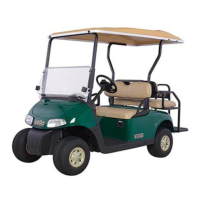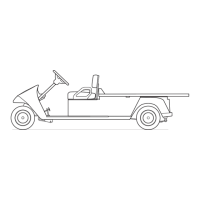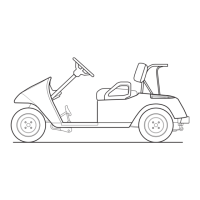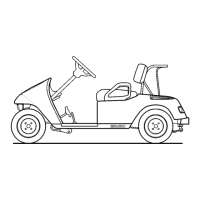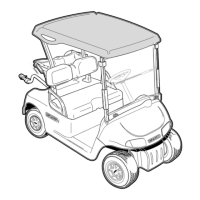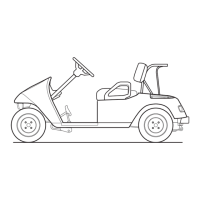OPERATION AND SERVICE INFORMATION
Page 14
Owner’s Manual and Service Guide
Read all of manual to become thoroughly familiar with this vehicle. Pay particular attention to all Notes, Cautions and Warnings
TIRE INSPECTION
Tire condition should be inspected per the Periodic Service
Schedule (Ref. Fig. 17 on page 12). Inflation pressures
should be checked when the tires are cool. Be sure to install
the valve dust cap after checking or inflating.
CHECKING THE OIL LEVEL
Do not overfill engine. Too much oil may
cause engine to smoke or spark plug
fouling.
When adding oil between oil changes, do not
mix brands and viscosity grades of oil. Both the
oil dipstick and fill cap must be in place before operating the
engine. Failure to install the dipstick and fill cap will result in oil
becoming contaminated and/or oil being discharged into the
engine compartment.
The oil should be checked with the engine warm. The
vehicle must be on a level surface with the park brake
engaged. Allow adequate time for oil to drain into the
crankcase before checking.
Remove the dipstick and wipe off the entire area indicated
with a lint free cloth (Ref. Fig. 18 on page 14).
Insert the dipstick fully into the dipstick hole and remove.
Examine the level of oil on the dipstick.
The engine can be operated safely as long as oil is within
the safe operating range as indicated on the dipstick. Do
not operate vehicle if oil level is below the safe area
indicated on the dipstick (Ref. Fig. 19 on page 14).
Oil should be added to bring the level into the safe operating
range. Do not overfill. Check that the oil fill cap and dipstick
are firmly in place.
CHANGING THE OIL
Tool List Qty. Required
Socket, 10 mm, 3/8" drive................................................ 1
Ratchet, 3/8" drive ........................................................... 1
Extension, 8", 3/8" drive................................................... 1
Oil drain pan .................................................................... 1
For maximum performance and longevity, the engine oil
should be replaced every 125 hours of operation or semi-
annually, whichever comes first.
The selection of oil is dependent upon the service that the
vehicle will perform. Most vehicles require 10W-30 oil,
whereas vehicles used at capacity or near capacity load
applications will require 10W-40 oil after run-in (Ref. Fig. 20
on page 15).
To reduce the possibility of
severe injury, wear rubber
gloves to protect skin from
exposure to hot, used oil
and degreaser. These fluids contain chemicals known to
cause cancer.
The oil should be changed with the engine warm. Park the vehicle
on a level surface, engage the park brake and remove the key.
500 HOURS (includes items listed in previous tables & the following)
TIMING BELT ✓ Check tension and for signs of wear/damage, replace if worn or damaged
CARBURETOR ♦ Clean
CYLINDER HEAD AND PISTONS
♦ Remove carbon from cylinder head and pistons
✓ Check valve seats for carbon buildup and clean as required
Fig. 17 Periodic Service Schedule
Fig. 18 Clean Entire Dipstick
F
Ref Ced 1
Fig. 19 Check Oil Level on Dipstick
Maximum oil level
DO NOT OVERFILL
Safe
operating range
Add
oil
Full
ef Dsk 1
! !

